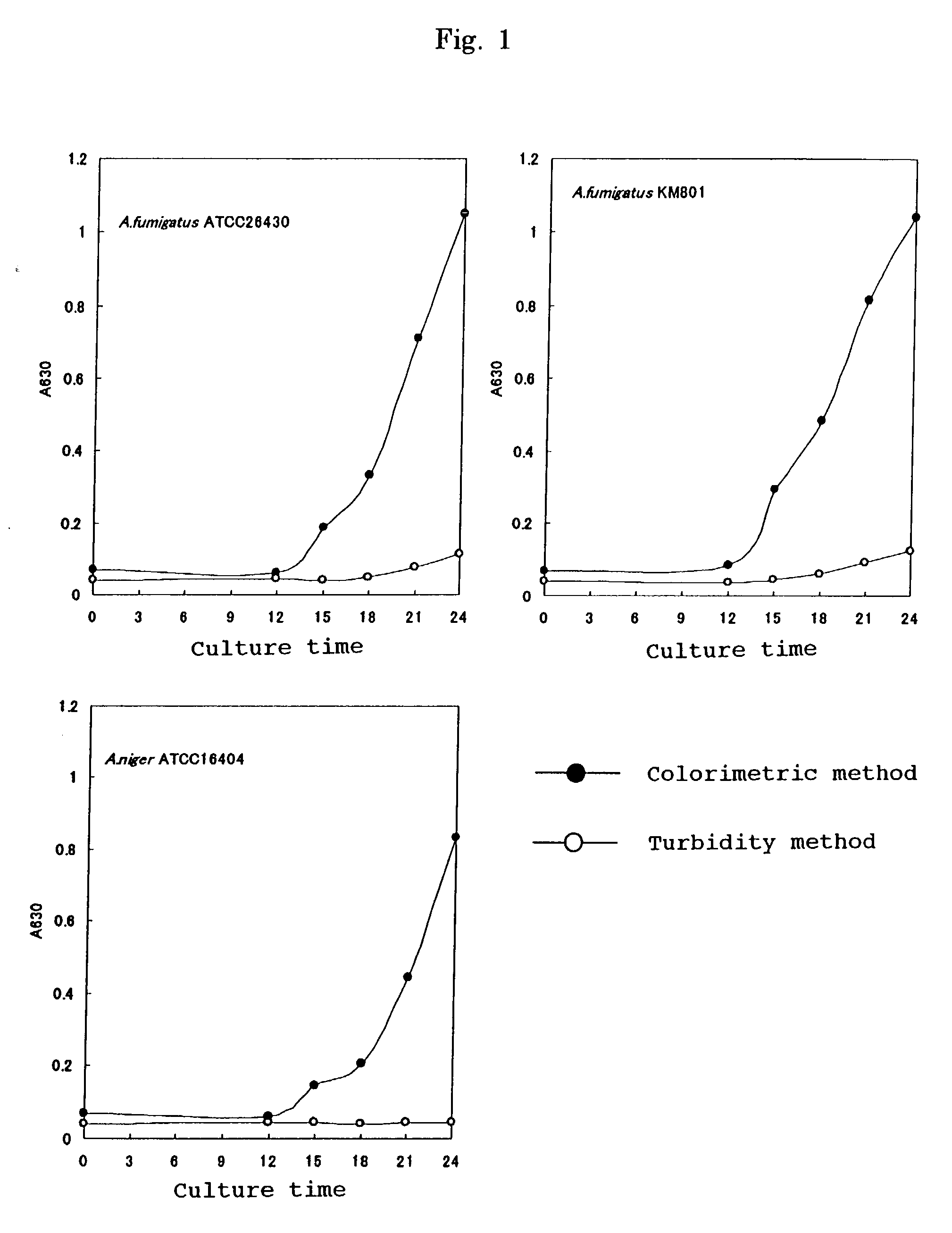Method for detecting microorganisms and detection kit
a microorganism and detection kit technology, applied in microorganism testing/measurement, biochemistry apparatus and processes, enzymes, etc., can solve the problems of inability to accurately measure, complicated operation, and long time for testing
- Summary
- Abstract
- Description
- Claims
- Application Information
AI Technical Summary
Problems solved by technology
Method used
Image
Examples
example 1
[0045] In order to select a growth culture medium the following procedures were carried out.
[0046] A. Strain Used
[0047] Aspergillus Fumigatus KM8001 was Used.
[0048] B. Test Method
[0049] (1) Preparation of Culture Medium
[0050] 1) MOPS Buffered RPMI 1640 Culture Medium Supplemented with Added Glucose
[0051] 10.4 g of RPMI 1640 culture medium powder (containing L-glutamine, no sodium hydrogen carbonate, and no Phenol Red, manufactured by Gibco), 2.0 g of sodium hydrogen carbonate, 10.0 g of glucose, and 34.53 g of 3-morpholinopropanesulfonic acid (MOPS) were dissolved in 900 mL of purified water, and the pH was adjusted to 7.0 with a 1N aqueous solution of sodium hydroxide. The solution was made up to 1000 mL and then filtered using a 0.2 .mu.m filter.
[0052] 2) Preparation of Glucose YN Broth
[0053] 6.7 g of YN Base (manufactured by Difco) and 5 g of glucose were dissolved in about 900 mL of purified water, and the pH was adjusted to 5.3 with a 1N aqueous solution of sodium hydroxide. Th...
example 2
[0061] In order to measure the degree of proliferation of a filamentous fungus the following procedures were carried out.
[0062] A. Strains Used
[0063] Aspergillus Fumigatus ATCC26430, Aspergillus Fumigatus KM8001, and Aspergillus niger ATCC16404 were used.
[0064] B. Test Method
[0065] (1) Preparation of Sucrose YN Broth
[0066] 6.7 g of YN Base (manufactured by Difco) and 20 g of sucrose were dissolved in about 900 mL of purified water, and the pH was adjusted to 7.0 with a 1N aqueous solution of sodium hydroxide. The solution was made up to 1000 mL with purified water and then filter sterilized using a 0.2 .mu.m filter.
[0067] (2) Preparation of Inoculum and Culturing
[0068] A tester strain was cultured using Sabouraud Dextrose Agar (manufactured by OXOID) at 35.degree. C. for 7 days. 2 mL of sterile physiological saline containing 0.1% Tween 80 was added dropwise onto the culture medium so as to float spores. The above-mentioned physiological saline that had been added dropwise onto the ...
example 3
[0076] In order to examine the applicability to antifungal drug susceptibility testing the following procedures were carried out.
[0077] A. Strain Used
[0078] Aspergillus Fumigatus ATCC26430 was Used.
[0079] B. Microplate Used for Test
[0080] Two drugs, Amphotericin B (AMPH) and Itraconazole (ITCZ) were examined. 2-fold dilution series of AMPH (0.3 to 160 .mu.g / mL) and ITCZ (0.16 to 80 .mu.g / mL) were prepared using dimethyl sulfoxide and purified water. The drug solutions so prepared were pipetted into a plate at 0.02 mL / well and dried to a solid under reduced pressure for 24 hours. A coloring reagent (containing 0.7 mmol / L WST-8, 0.0035 mmol / L 1-methoxy PMS, 0.5 mmol / L potassium ferricyanide, and 0.5 mmol / L of potassium ferrocyanide) was pipetted into each of the wells at 0.02 mL / well and they were again dried to a solid under reduced pressure for 24 hours.
[0081] C. Test Method
[0082] (1) Turbidity Method
[0083] A comparative example was carried out according to NCCLS M-38P (0.2 mL cultu...
PUM
| Property | Measurement | Unit |
|---|---|---|
| culture time | aaaaa | aaaaa |
| culture time | aaaaa | aaaaa |
| pH | aaaaa | aaaaa |
Abstract
Description
Claims
Application Information
 Login to View More
Login to View More - R&D
- Intellectual Property
- Life Sciences
- Materials
- Tech Scout
- Unparalleled Data Quality
- Higher Quality Content
- 60% Fewer Hallucinations
Browse by: Latest US Patents, China's latest patents, Technical Efficacy Thesaurus, Application Domain, Technology Topic, Popular Technical Reports.
© 2025 PatSnap. All rights reserved.Legal|Privacy policy|Modern Slavery Act Transparency Statement|Sitemap|About US| Contact US: help@patsnap.com


